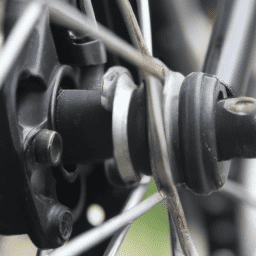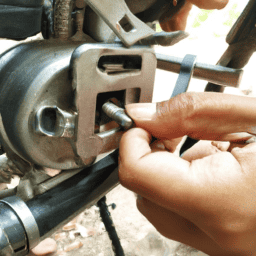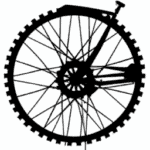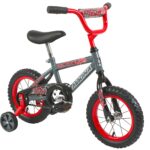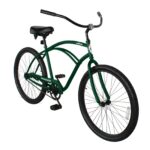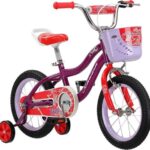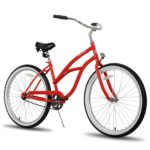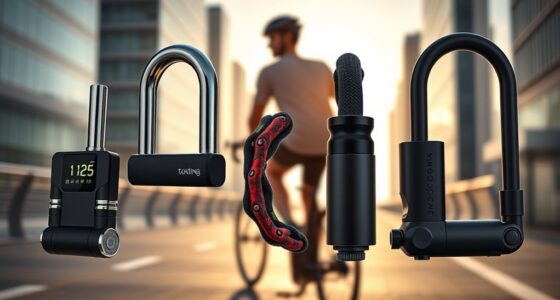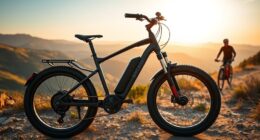As someone passionate about cycling, I’ve encountered a range of brake systems utilized in diverse bicycles. Among these, the coaster brake stands out as a frequently seen mechanism, especially on cruiser bicycles and those designed for children. For those unfamiliar with coaster brakes, you might be curious about their function and operation.
In this article, I will provide a detailed explanation of what a coaster brake is, how it works, its pros and cons, and how to choose the right brake system for your bike.
A coaster brake is a type of brake system that is integrated into the rear hub of a bicycle. Unlike other brake systems that use cables to activate the brake pads, a coaster brake uses a mechanism that is built into the rear hub. This mechanism is activated when the rider pedals backward, causing the brake shoes inside the hub to press against the inside of the hub shell, which slows down or stops the bike.
The design of the coaster brake is simple and effective, making it a popular choice for many riders. However, there are some limitations to this type of brake system, which we will explore in this article.
Key Takeaways
- A coaster brake is a type of bicycle brake system integrated into the rear hub that is activated by pedaling backward.
- It is a simple and effective way to stop a bike without using hands, but it is less effective than hand brakes at higher speeds or on steep hills.
- Coaster brakes require less maintenance than traditional brake systems and prevent skids, but they have limited stopping power and less control.
- Choosing the right brake system depends on terrain and level of experience, with hydraulic disc brakes providing better stopping power and control on descents and in wet conditions.
Definition of a Coaster Brake
A coaster brake is a type of bicycle brake that is activated by pedaling backwards. It is commonly found on cruiser bikes, kids’ bikes, and some BMX bikes. The coaster brake is integrated into the rear hub of the bike, making it a simple and low-maintenance braking system.
One advantage of a coaster brake is that it allows for easy stopping without having to use your hands, which can be particularly useful for young children who may not have developed the coordination to use hand brakes. However, coaster brakes are not as effective as hand brakes, especially at higher speeds or on steep hills.
Additionally, since the coaster brake is located in the rear hub, it can be difficult to repair or replace if it becomes damaged.
Moving onto how a coaster brake works, it is important to understand the basics of the rear hub.
How a Coaster Brake Works
You might not realize it, but when you pedal backwards on your bike, you’re actually engaging a mechanism that slows down the wheel and brings you to a stop. This mechanism is known as a coaster brake, and it’s a popular type of brake system used on bicycles.
The coaster brake mechanism is a simple and effective design that works by using a series of gears and a brake shoe to slow down the rotation of the rear wheel. When you pedal forwards, the brake is disengaged, allowing the wheel to spin freely. However, when you pedal backwards, the brake is engaged, causing the brake shoe to press against the inner surface of the hub shell and slow down the wheel.
Advantages of using a coaster brake include its low maintenance requirements, as it doesn’t require cables or brake pads to function. It’s also a reliable system that is less prone to failure than traditional brake systems. Additionally, because the brake is internal, it doesn’t interfere with the aesthetics of the bike, making it a popular choice for vintage and retro-style bicycles.
In the next section, we’ll take a closer look at some of the pros of using a coaster brake and why it might be the right choice for your bike.
Pros of Using a Coaster Brake
As a bike rider, I’ve found that using a coaster brake has some significant advantages.
Firstly, its simplicity and low maintenance make it an ideal choice for anyone who wants to avoid complicated brake systems.
Secondly, it offers safety benefits such as preventing skids and ensuring a smooth stop.
Lastly, it’s a great option for those who want to ride with ease and without the worry of brake failures.
Simplicity and Low Maintenance
With a coaster brake, maintenance is a breeze and you won’t have to worry about complex mechanical systems. As someone who’s used this type of brake on my bike for years, I can attest to the simplicity and low maintenance that comes with it.
Here are some reasons why:
- No external cables or levers to adjust or replace, which means less hassle and expense.
- Less wear and tear on brake pads, which means fewer replacements needed over time.
- Easy to disassemble and clean, which ensures that your coaster brake will last longer and remain effective.
- No need for periodic lubrication, which means less time and money spent on maintenance.
Overall, the simplicity and low maintenance of a coaster brake make it an attractive option for those who want a reliable and easy-to-use braking system on their bike. While there are some disadvantages to consider, such as limited stopping power and difficulty in performing certain maneuvers, the cost comparison and ease of maintenance make it a great choice for many riders.
When it comes to safety benefits, a coaster brake can provide some added peace of mind. While it may not have the stopping power of other types of brakes, it’s still effective in slowing down your bike and can be a good option for those who ride primarily on flat terrain.
Additionally, the simplicity of the system means that there are fewer parts that can fail or malfunction, reducing the risk of accidents caused by brake failure. With that said, it’s important to remember that no brake system can guarantee absolute safety, and it’s always important to ride responsibly and wear appropriate safety gear.
Safety Benefits
When riding your bike, it’s important to consider the safety benefits of an effective braking system. A coaster brake is one type of braking system that can be found on bicycles. It is a simple and reliable system that is activated by pedaling backwards, which engages the brake and slows down the bike.
However, while a coaster brake may be suitable for some types of riding, it may not be the best option for all situations. The table below outlines the advantages and disadvantages of using a coaster brake compared to other brake systems for different types of riding. It’s important to weigh the pros and cons and choose the braking system that is best for your needs to ensure maximum safety while riding.
| Type of Riding | Advantages of Coaster Brake | Disadvantages of Coaster Brake | Other Brake System Alternatives |
|---|---|---|---|
| Commuting | Easy to use, low maintenance | Limited stopping power, less control | Rim or disc brakes |
| Mountain Biking | None | Limited stopping power, less control | Disc brakes |
| Road Cycling | None | Limited stopping power, less control | Rim brakes |
While coaster brakes may offer simplicity and low maintenance, they may not be the safest option for all types of riding. As we will discuss in the next section, there are some cons of using a coaster brake that should be considered.
Cons of Using a Coaster Brake
Unfortunately, using a coaster brake on a bicycle can make it difficult to brake suddenly in emergency situations. This can pose a serious risk, especially when riding in high-traffic areas or steep hills. As someone who’s experienced the limitations of coaster brakes firsthand, I strongly advise against using them as your primary braking system. Here are three disadvantages of using a coaster brake on your bike:
-
Limited Control: Coaster brakes only allow you to brake with your feet, which can be less precise than using your hands. This means you may not be able to control your stopping power as effectively, which can be dangerous in certain situations.
-
No Freewheeling: With a coaster brake, you can’t coast without pedaling. This can be frustrating on long rides, as your legs may tire quickly without the ability to take breaks and coast.
-
Limited Customization: Coaster brakes are typically built into the rear hub of your bike, which means you can’t easily switch them out for different types of brakes. This can limit your ability to customize your bike to your specific needs.
To ensure your safety and improve your biking experience, it’s important to consider alternatives to coaster brakes. In the next section, we’ll discuss how to choose the right brake system for your bike.
How to Choose the Right Brake System for Your Bike
To ensure your safety and improve your overall biking experience, you should consider selecting a brake system that suits your specific needs. The type of terrain you frequently ride on and your level of experience as a rider are some of the factors that should influence your brake system choice.
For instance, if you frequently ride on steep hills or mountainous terrain, you may want to opt for a hydraulic disc brake system as it provides better stopping power and control on descents. On the other hand, if you mainly ride on flat surfaces or in the city, a traditional rim brake or a coaster brake may suffice.
Weather conditions can also affect brake performance, so it’s essential to consider this when selecting a brake system. Wet conditions can cause rim brakes to lose their stopping power, while coaster brakes may not work as well in wet or muddy conditions. If you live in an area with frequent rain or snow, you may want to choose a hydraulic disc brake system that provides consistent stopping power regardless of the weather.
Ultimately, choosing the right brake system for your bike can make a significant difference in your overall riding experience and safety.
Frequently Asked Questions
Can a coaster brake be installed on any type of bicycle?
Installing a coaster brake on any bike depends on its compatibility. The process involves removing the rear wheel, attaching the brake arm to the frame, and adjusting the hub. It’s a technical job best handled by a professional bike mechanic.
How does a coaster brake compare to other types of brakes in terms of stopping power?
Compared to other types of bicycle brakes, coaster brakes have lower stopping power and are less effective in wet conditions. However, they are low maintenance, easy to use, and can help prevent skids and overuse of the front brake.
Are coaster brakes more or less expensive than other brake systems?
When comparing cost and durability of brake systems, coaster brakes are often less expensive but may require more maintenance than other options. However, this assessment is incomplete without considering the specific needs and usage of the bicycle.
Can a coaster brake be used in wet or slippery conditions?
When it’s wet out, coaster brakes can be a bit of a slippery slope. But with proper maintenance, they can still be effective in mud. Keep them clean and dry to ensure optimal performance.
Are there any maintenance or upkeep requirements specific to coaster brakes?
Coaster brakes require regular maintenance to ensure proper function. Lubrication frequency depends on usage and conditions. Common issues include sticking, dragging, and loss of braking power. These can often be resolved with proper cleaning and adjustment.
Conclusion
After learning about coaster brakes, I’m intrigued by how they work and their benefits. The idea of being able to slow down or stop my bike by pedaling backward seems almost magical, and I can imagine the feeling of control it would provide.
However, the potential for overheating and reduced stopping power in wet conditions makes me hesitant to switch to a coaster brake.
Ultimately, choosing the right brake system for your bike comes down to personal preference and the type of riding you’ll be doing. Whether you opt for a coaster brake or another type of brake, make sure to properly maintain and test your brakes before hitting the road.
As a cyclist, having a reliable and effective braking system is crucial for your safety and the safety of those around you. So, take the time to research and choose the best brake system for your needs, and enjoy the ride with confidence and control.
